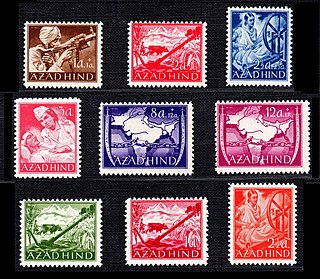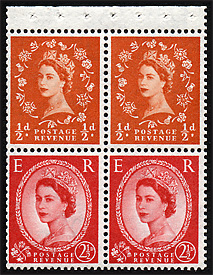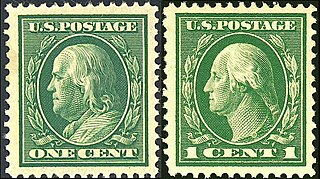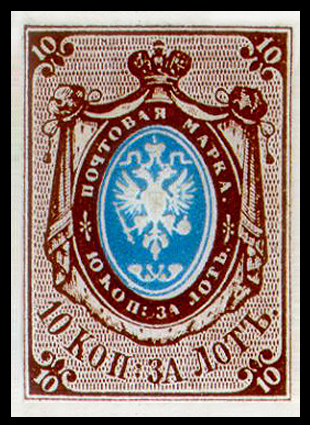
A postage stamp is a small piece of paper issued by a post office, postal administration, or other authorized vendors to customers who pay postage. Then the stamp is affixed to the face or address-side of any item of mail—an envelope or other postal cover —which they wish to send. The item is then processed by the postal system, where a postmark or cancellation mark—in modern usage indicating date and point of origin of mailing—is applied to the stamp and its left and right sides to prevent its reuse. Next the item is delivered to its addressee.

The Penny Black was the world's first adhesive postage stamp used in a public postal system. It was first issued in the United Kingdom on 1 May 1840 but was not valid for use until 6 May. The stamp features a profile of Queen Victoria.

The postal and philatelic history of Canada concerns postage of the territories which have formed Canada. Before Canadian confederation, the colonies of British Columbia and Vancouver Island, Prince Edward Island, Nova Scotia, New Brunswick and Newfoundland issued stamps in their own names. The postal history falls into four major periods: French control (1604–1763), British control (1763–1841), colonial government control (1841–1867), and Canada, since 1867.

The Penny Red was a British postage stamp, issued in 1841. It succeeded the Penny Black and continued as the main type of postage stamp in the United Kingdom of Great Britain and Ireland until 1879, with only minor changes to the design during that time. The colour was changed from black to red because of difficulty in seeing a cancellation mark on the Penny Black; a black cancellation mark was readily visible on a Penny Red.

Postage stamps and postal history of Great Britain surveys postal history from the United Kingdom and the postage stamps issued by that country and its various historical territories until the present day.

The postage stamps and postal system of the Confederate States of America carried the mail of the Confederacy for a brief period in American history. Early in 1861 when South Carolina no longer considered itself part of the Union and demanded that the U.S. Army abandon Fort Sumter, plans for a Confederate postal system were already underway. Indeed, the Confederate Post Office was established on February 21, 1861; and it was not until April 12 that the American Civil War officially began, when the Confederate Army fired upon US soldiers who had refused to abandon the fort. However, the United States Post Office Department continued to handle the mail of the seceded states as usual during the first weeks of the war. It was not until June 1 that the Confederate Post Office took over collection and delivery, now faced with the task of providing postage stamps and mail services for its citizens.

The history of postage stamps and postal history of Malaysia, a state in Southeast Asia that occupies the south of the Malay peninsula and Sarawak and Sabah in the north Borneo, includes the development of postal services in these periods:

The Machin series of postage stamps is the main definitive stamp series in the United Kingdom, used since 5 June 1967. It is the second series to figure the image of Elizabeth II, replacing the Wilding series. The last issue was on 4 April 2022, four months before her death on 8 September.

The Columbian Issue, also known as the Columbians, is a set of 16 postage stamps issued by the United States to commemorate the World's Columbian Exposition held in Chicago during 1893. The finely-engraved stamps were the first commemorative stamps issued by the United States, depicting various events during the career of Christopher Columbus and are presently much valued by collectors.

The Chalon Head is the name of a number of postage stamp series whose illustration was inspired by a portrait of Queen Victoria by Alfred Edward Chalon (1780–1860).

The Azad Hind stamps are a set of prepared but never issued stamps for the planned Provisional Government of Free India under Subhas Chandra Bose. All stamps were printed by photogravure in sheets of 100 at the Reichsdruckerei, the Government Printing Bureau in Berlin.

The Wildings were a series of definitive postage and revenue stamps featuring the Dorothy Wilding photographic portrait of Queen Elizabeth II that were in use between 1952 and 1971. The Wildings were the first and only British stamps to feature graphite lines on the back, and the first to feature phosphor bands on the face – both aids to automation. The stamps were also the first British pictorial high value stamps and the first to include regional emblems.

Plating refers to the reconstruction of a pane or "sheet" of postage stamps printed from a single plate by using individual stamps and overlapping strips and blocks of stamps. Likewise, if a sheet 10 or 20 postal cards is typeset, the variations of the letters or design elements may allow reconstruction or plating of the sheets based on these differences.

The Washington–Franklin Issues are a series of definitive U.S. Postage stamps depicting George Washington and Benjamin Franklin, issued by the U.S. Post Office between 1908 and 1922. The distinctive feature of this issue is that it employs only two engraved heads set in ovals—Washington and Franklin in full profile—and replicates one or another of these portraits on every stamp denomination in the series. This is a significant departure from previous definitive issues, which had featured pantheons of famous Americans, with each portrait-image confined to a single denomination. At the same time, this break with the recent past represented a return to origins. Washington and Franklin, after all, had appeared on the first two American stamps, issued in 1847, and during the next fifteen years, each of the eight stamp denominations available featured either Washington or Franklin.

The Regular Issues of 1922–1931 were a series of 27 U.S. postage stamps issued for general everyday use by the U.S. Post Office. Unlike the definitives previously in use, which presented only a Washington or Franklin image, each of these definitive stamps depicted a different president or other subject, with Washington and Franklin each confined to a single denomination. The series not only restored the historical tradition of honoring multiple presidents on U.S. Postage but extended it. Offering the customary presidential portraits of the martyred Lincoln and Garfield, the war hero Grant, and the founding fathers Washington and Jefferson, the series also memorialized some of the more recently deceased presidents, beginning with Hayes, McKinley, Cleveland and Roosevelt. Later, the deaths of Harding, Wilson and Taft all prompted additions to the presidential roster of Regular Issue stamps, and Benjamin Harrison's demise (1901) was belatedly deemed recent enough to be acknowledged as well, even though it had already been recognized in the Series of 1902. The Regular Issues also included other notable Americans, such as Martha Washington and Nathan Hale—and, moreover, was the first definitive series since 1869 to offer iconic American pictorial images: these included the Statue of Liberty, the Capitol Building and others. The first time (1869) that images other than portraits of statesmen had been featured on U.S. postage, the general public disapproved, complaining that the scenes were no substitute for images of presidents and Franklin. However, with the release of these 1922 regular issues, the various scenes—which included the Statue of Liberty, the Lincoln Memorial and even an engraving of an American Buffalo—prompted no objections. To be sure, this series presented pictorial images only on the higher-value stamps; the more commonly used denominations, of 12 cents and lower, still offered the traditional portraits.

A printer's sample stamp is a label produced by a printer resembling a stamp, but with no postal or other validity. Often it will include the name of the printer and demonstrate their printing capabilities. The stamps are not intended for use and are therefore to be distinguished from test stamps, though both test stamps and printer's sample stamps are dummy stamps in the broadest sense of that term.

The Series of 1902, also known as the Second Bureau Issue, is a set of definitive postage stamps in fourteen denominations ranging between one cent and five dollars, produced by the U. S. Bureau of Engraving and Printing and issued by the United States Post Office. Two denominations appeared in November and December 1902 and the other twelve were released between January and June 1903. These stamps were assigned the Scott Catalogue numbers 300 through 313. Also considered part of the series is a fifteenth stamp which appeared in November 1903—a second version of the 2¢ value, the original having faced severe criticism. This series, particularly noted for its exceptional ornateness and opulence of design, remained in circulation until late 1908, when it was superseded by the Washington-Franklin Issues.

New Zealand first issued revenue stamps on 1 January 1867 and their general use continued until the early 1950s. The only Revenue Stamp series still in use today is the Game Bird Habitat stamp which is used for payment of the Gun License for the duck shooting season which begins the first weekend of May. There were various types of fiscal stamps for different taxes.

The first stamp of the Russian Empire was a postage stamp issued in 1857 and introduced within the territory of the Russian Empire in 1858. It was an imperforate 10-kopeck stamp depicting the coat of arms of Russia, and printed using typography in brown and blue.




















